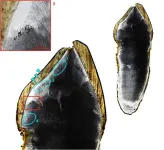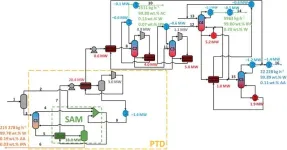(Press-News.org) AURORA, Co. (January 31, 2024) - A collaborative cohort of researchers, led by University of Colorado Anschutz Medical Campus professor Angelo D’Alessandro, have identified kynurenine as a critical new biomarker in the quality of stored red blood cells (RBCs), a crucial step in the development of more personalized transfusions. Study results published today in the journal Blood.
The transfusion of RBCs is one of the most common in-hospital medical procedures second only to vaccination. The blood supply is dependent on altruistic blood donors, and donated RBCs are stored in blood banks for up to 42 days until transfusion. Defining and characterizing the criteria for qualifying RBC storage is an underexplored component of transfusion medicine, and the quality of stored RBCs is critical for a successful transfusion. Time is a factor, as the effectiveness of RBCs wanes the longer they are stored. In a study published today in blood, researchers explored how various biomarkers, such as donor age, sex and BMI make a difference in the storage of blood.
Results indicate that blood with high levels of kynurenine, a metabolite that plays a critical role in immune response predominantly found in participants with high BMI, male donors and older female donors, is a marker of fragility, which impacts the cells’ susceptibility to rupturing. Blood with higher levels of kynurenine is more likely to break down faster. When classifying blood units based on the levels of this new biomarker, researchers discovered that the quality of blood is dependent on donor traits just as much, or more so, than the time it was stored in the blood bank.
“Blood transfusion is the cornerstone of modern medical practices, with more than 100 million units used per year in life-dependent and life-saving circumstances,” says D’Alessandro. “Our research underscores the potential of personalized transfusion medicine. By focusing on kynurenine as a marker, we can better understand and predict the quality of stored blood, tailoring transfusion practices to individual patient needs.” Dr. Kirk Hansen from the CU Trauma Research Center added, “Blood transfusion is a key life-saving intervention for millions of military and trauma patients in the US every year.”
This study utilized a shared biobank and database from the Recipient Epidemiology and Donor Evaluation Study (REDS-III), a comprehensive, multi-site initiative aimed at improving the blood transfusion process. Researchers were able to analyze cellular data from a diverse pool of more than 13,000 donors, nearly 700 of whom were called back for a second donation. Providing additional support, the researchers leveraged a population of over 500 different mouse strains, each with unique genetics and biology. This approach allowed researchers to more broadly understand how metabolic changes contribute to the longevity of blood.
“For the first time, we link kynurenine levels and genetic traits that regulate them to outcomes in almost 5,000 transfusion recipients, a remarkable connection that highlights the impact of donor-specific traits on transfusion efficacy,” says Travis Nemkov. “Studies like this are critical in ensuring a sustainable future in transfusion medicine, determining biomarkers that indicate which blood would be more effective, as scarcity continues to be a problem for millions of patients who rely on transfusions. Interestingly, we’re now also observing comparable signatures in instances of extreme physiological stress like ultramarathon running, which causes similar RBC damage. Making these connections illustrate another utility in studying the blood donor population and we look forward to our future work in this space.”
END
CU Anschutz researchers identify new biomarker in quality of blood donations
Understanding how biomarkers impact blood efficacy can lead to personalized transfusion medicine
2024-01-31
ELSE PRESS RELEASES FROM THIS DATE:
38% of surveyed Danish owners put their dogs on unlicensed cannabinoids
2024-01-31
In a new study, 38 percent of dog owners surveyed in Denmark reported giving their pups cannabinoids, particularly cannabidiol or CBD. Pernille Holst and colleagues at the University of Copenhagen, Denmark present these findings in the open-access journal PLOS ONE on January 31.
Cannabis has become popular for recreational and medical use in humans, and many cannabis-based products are also available for pets. But because cannabis is not legal for veterinary use in countries such as Denmark, pet owners are using it without a prescription. To understand how common unlicensed cannabinoid use for pets is in Denmark, Holst and colleagues distributed an anonymous ...
After big shocks such as the pandemic lockdowns and the invasion of Ukraine, happiness levels may return to normal in as little as 2-3 weeks, per sentiment analysis of tweets in ten countries
2024-01-31
After big shocks such as the pandemic lockdowns and the invasion of Ukraine, happiness levels may return to normal in as little as 2-3 weeks, per sentiment analysis of tweets in ten countries
###
Article URL: https://journals.plos.org/plosone/article?id=10.1371/journal.pone.0295896
Article Title: Reactions to macro-level shocks and re-examination of adaptation theory using Big Data
Author Countries: South Africa, New Zealand
Funding: The authors received no specific funding for this work. END ...
Non-invasive wearable devices might be able to predict preterm birth by monitoring changes in maternal heart rate variability
2024-01-31
Non-invasive wearable devices might be able to predict preterm birth by monitoring changes in maternal heart rate variability
###
Article URL: https://journals.plos.org/plosone/article?id=10.1371/journal.pone.0295899
Article Title: Wearable-derived maternal heart rate variability as a novel digital biomarker of preterm birth
Author Countries: USA
Funding: The authors received no specific funding for this work. END ...
Childhood vitamin D deficiency was likely prevalent during industrialization in England
2024-01-31
Evidence from teeth reveals that vitamin D deficiency during childhood was likely a major issue in industrialized England, according to a study published January 31, 2024 in the open-access journal PLOS ONE by Anne Marie Snoddy of the University of Otago, New Zealand and colleagues.
The 18th and 19th centuries AD were a period of industrialization and urbanization in England. This was also a time of increasing incidence of health issues like vitamin D deficiency (VDD) and associated conditions like rickets, potentially linked to changing social practices ...
Archaeological evidence of seasonal vitamin D deficiency discovered
2024-01-31
Rickets ran rife in children following the Industrial Revolution, but University of Otago-led research has found factory work and polluted cities aren’t entirely to blame for the period’s vitamin D deficiencies.
In a Marsden funded study, just published in PLOS One, researchers from Otago, Durham University, University of Edinburgh, University of Brighton, and University of Queensland, sampled teeth from a cemetery site in industrial era England, looking for microscopic markers of nutritional disease.
Lead author Dr Annie Sohler-Snoddy, Research ...
Jennifer J. Raab named President and CEO of The New York Stem Cell Foundation
2024-01-31
NEW YORK, NY (January 31, 2024) – The New York Stem Cell Foundation (NYSCF) announced today that, following a nationwide search, its Board of Directors has named Hunter College President Emerita Jennifer J. Raab as its next President and Chief Executive Officer, effective this month.
NYSCF is one of the world’s leading nonprofit stem cell organizations, raising and investing more than $450 million since its founding in 2005 to accelerate cures for the major diseases of our time through stem cell research. The foundation conducts its own pioneering research at the NYSCF Research Institute laboratories in Manhattan, informs and convenes scientists and ...
A new way to visualize brain cancer
2024-01-31
Brigham and MIT researchers uncovered never-before-seen details in human brain tissue with new, inexpensive microscopy technology.
KEY TAKEAWAYS
Researchers have developed a new microscopy technology called decrowding expansion pathology (dExPath) to analyze brain tissue.
By pulling proteins apart with dExPath, researchers can stain proteins in tissue that could not be accessed before, highlighting nanometer sized structures or even cell populations that were previously hidden.
This “super-resolution imaging” technology ...
AI can predict brain cancer patients’ survival
2024-01-31
Artificial Intelligence (AI) can predict whether adult patients with brain cancer will survive more than eight months after receiving radiotherapy treatment.
The use of the AI to successfully predict patient outcomes would allow clinicians to be better informed for planning the next stage of treatment and refer patients to potentially life-saving treatment quicker.
This is the first use of AI to predict short-term and long-term survivors within eight-months of radiotherapy.
The paper published recently in Neuro-Oncology shows how researchers ...
Fermentation revolution? Trash becomes treasure as bio-waste yields valuable acetone and isopropanol
2024-01-31
In a major stride towards sustainable industrial fermentation, a team of researchers at Delft University of Technology (TU Delft) in The Netherlands, has unveiled pioneering advancements in the purification of isopropanol and acetone from the fermentation of waste gases. The study, published in SCI's Journal of Chemical Technology and Biotechnology, introduces novel processes that promise to elevate the efficiency and viability of large-scale production.
Isopropanol and acetone have a combined global market of $10 billion. Both chemicals are important industry solvents and isopropanol ...
The hottest catalog of the year: the most comprehensive list of slow-building solar flares yet
2024-01-31
Solar flares occur when magnetic energy builds up in the Sun’s atmosphere and is released as electromagnetic radiation. Lasting anywhere from a few minutes to a few hours, flares usually reach temperatures around 10 million degrees Kelvin. Because of their intense electromagnetic energy, solar flares can cause disruptions in radio communications, Earth-orbiting satellites and even result in blackouts.
Although flares have been classified based on the amount of energy they emit at their peak, there has not been significant study into differentiating ...
LAST 30 PRESS RELEASES:
Sleeping in on weekends may help boost teens’ mental health
Study: Teens use cellphones for an hour a day at school
After more than two years of war, Palestinian children are hungry, denied education and “like the living dead”
The untold story of life with Prader-Willi syndrome - according to the siblings who live it
How the parasite that ‘gave up sex’ found more hosts – and why its victory won’t last
When is it time to jump? The boiling frog problem of AI use in physics education
Twitter data reveals partisan divide in understanding why pollen season's getting worse
AI is quick but risky for updating old software
Revolutionizing biosecurity: new multi-omics framework to transform invasive species management
From ancient herb to modern medicine: new review unveils the multi-targeted healing potential of Borago officinalis
Building a global scientific community: Biological Diversity Journal announces dual recruitment of Editorial Board and Youth Editorial Board members
Microbes that break down antibiotics help protect ecosystems under drug pollution
Smart biochar that remembers pollutants offers a new way to clean water and recycle biomass
Rice genes matter more than domestication in shaping plant microbiomes
Ticking time bomb: Some farmers report as many as 70 tick encounters over a 6-month period
Turning garden and crop waste into plastics
Scientists discover ‘platypus galaxies’ in the early universe
Seeing thyroid cancer in a new light: when AI meets label-free imaging in the operating room
Neutrophil-to-lymphocyte ratio may aid risk stratification in depressive disorder
2026 Seismological Society of America Annual Meeting
AI-powered ECG analysis offers promising path for early detection of chronic obstructive pulmonary disease, says Mount Sinai researchers
GIMM uncovers flaws in lab-grown heart cells and paves the way for improved treatments
Cracking the evolutionary code of sleep
Medications could help the aging brain cope with surgery, memory impairment
Back pain linked to worse sleep years later in men over 65, according to study
CDC urges ‘shared decision-making’ on some childhood vaccines; many unclear about what that means
New research finds that an ‘equal treatment’ approach to economic opportunity advertising can backfire
Researchers create shape-shifting, self-navigating microparticles
Science army mobilizes to map US soil microbiome
Researchers develop new tools to turn grain crops into biosensors
[Press-News.org] CU Anschutz researchers identify new biomarker in quality of blood donationsUnderstanding how biomarkers impact blood efficacy can lead to personalized transfusion medicine






